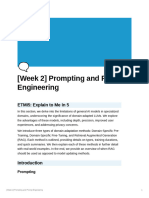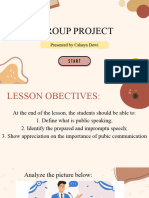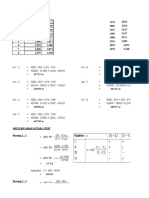LLM Prompt
Engineering
Techniques and Best
Practices
Ali Shafique · Follow
10 min read · Jun 29, 2024
Listen Share
What is Artificial Intelligence?
Artificial Intelligence (AI) is the branch of
computer science focused on creating
machines capable of performing tasks that
typically require human intelligence. This
includes learning from data, recognizing
patterns, making decisions, and
understanding natural language. AI aims to
develop systems that can think, learn, and
adapt autonomously, enhancing their
ability to solve complex problems and
perform various tasks efficiently.
Generative AI:
It is a type of artificial intelligence that can
create new content, such as text, images,
music, or videos, by learning patterns from
large datasets. Unlike traditional AI, which
might classify data or make predictions,
generative AI can produce original outputs
similar to human creations. Examples
include writing essays, generating art,
composing music, and creating realistic
simulations. Generative AI models, like
large language models (LLMs), are guided
by human instructions to produce the
desired text. The following image shows
the Venn diagram of artificial intelligence
and its subfields: highlighting Generative
AI.
Venn diagram representing various types of Artificial
Intelligence
Large Language Models refer to a type of
artificial intelligence model designed to
understand and generate human-like text
based on vast amounts of data it has been
trained on, for example, “Give me 5 ice
cream flavors”. The following list shows
popular large language models developed
by various companies and organizations:
OpenAI — GPT-4
Google — Gemini
Microsoft — Turing NLG
Facebook (Meta) — LLaMA (Large
OpenLanguage
in app Model Meta AI) Sign up Sign in
Anthropic — Claude
Amazon — AlexaTM
Baidu — ERNIE
Cohere — Command R
IBM — Watson NLP
Hugging Face — BLOOM (BigScience
Large Open-science Open-access
Multilingual Language Model)
LLMs use techniques such as deep learning
and transformers to process and generate
natural language text, enabling
applications like language translation,
chatbots, and text summarization. These
models have significantly advanced natural
language processing capabilities, making
them pivotal in various fields including
healthcare, customer service, and content
generation. The following image is adapted
from the link.
Prompting examples for large language models
Let’s take an example to see how LLMs
work. Consider a classification task in
natural language processing (NLP). In this
task, the objective is to determine the most
likely word that follows a given sequence
of words. For example, if the input
sequence is “The cat likes to sleep in the,”
the model predicts the next word, such as
“box,” based on the context and patterns in
the data.
This task involves:
Input: A sequence of words or tokens.
Output: Prediction of the next word in
the sequence.
Approach: It is treated as a
classification problem where the
model assigns probabilities to each
possible word in its vocabulary,
selecting the word with the highest
probability as the prediction as shown
below.
Classification task with probabilities of each word in
vocabulary
Another example showcasing the detailed
working process of an LLM image source:
Detailed flowchart showcasing the working of LLMs
What is Prompting:
A prompt is a natural language text that
requests generative AI models (LLMs) to
perform a specific task. Using a prompt to
instruct an AI to do a task is called
prompting.
Prompting examples of LLMs
Prompt Applications:
Prompt applications involve providing a
structured input or query (often in the
form of text) to instruct a language model
on what kind of response or action is
desired. Prompts can be used across
various applications such as:
Various NLP tasks and applications of large language
models
Issues with Prompting:
To understand the issues with prompting,
let’s take an example (source) in which We
will prompt the LLM to craft a marketing
tweet for our new, fictional AI product:
ArchaeologistAI, which narrates stories
about renowned archaeologists. On the left
side of the image given below, the tweet is
not accurate because ArchaeologistAI only
tells stories and does not make discoveries.
However, this isn’t the LLM’s fault, as it had
no prior information about
ArchaeologistAI. It can be corrected by
giving more details about ArchaeologistAI
on the right side of the image.
Incorrect LLM response (left) and correct response
(right)
This refining process of prompt is called
prompt engineering. Let’s discuss this term
in more detail.
What is prompt engineering?
Large language models (LLMs) are very
flexible and can do many things like
summarizing documents, completing
sentences, answering questions, and
translating languages. They generate the
best output based on their training when
given specific user input. Users can
interact with these AI models in countless
ways and these powerful AI models don’t
need much to start creating content; even a
single word can produce a detailed
response. Therefore, not all inputs lead to
useful outputs. Generative AI systems need
context and detailed information to
produce accurate and relevant responses.
Prompt engineering involves refining
prompts continuously until you achieve the
desired results from the AI system. This
process is especially helpful when basic
prompts aren’t effective.
Why is prompt engineering
important?
Enhanced Performance: Optimizes AI
responses by guiding models to
generate more coherent, accurate,
relevant and desired outputs.
Task Specialization: Tailors AI behavior
for specific tasks, improving efficiency
and effectiveness.
Error Reduction: Reduces the
likelihood of incorrect or irrelevant
outputs by providing clear instructions.
Practices and Techniques of Prompt
Engineering:
Here are some key practices and
techniques of prompt engineering:
1. Use the latest model
For optimal results, it is recommended to
use the latest LLM model versions. Newer
models are typically efficient and easy for
prompt engineering.
Pricing details for Gemini (left) and ChatGPT (right),
accessed on June 29, 2024.
2. Separate instruction and
context/input text
Place instructions at the beginning of the
prompt and use ### or “”” to separate the
instructions from the input text. This type
of prompting is also called instructional
prompting.
3. Be Specific and descriptive
Avoid a single broad prompt, be specific,
descriptive, and as detailed as possible
about the desired context.
4. Avoid “fluffy” descriptions
It means that when providing instructions
or queries to a language model or AI
system, you should avoid vague,
ambiguous, or overly general language.
Instead, you should use clear, specific, and
precise language that communicates what
you want the model to do or generate.
5. Instead of just saying what not to
do, say what to do instead
It means providing clear guidance when
formulating prompts or instructions for
language models. Rather than solely
emphasizing what should be avoided or
prohibited in a prompt, because it can lead
to countless imprecise outputs.
6. Articulate the desired output
format:
It refers to clearly defining and
communicating how you want the
response or output to be structured and
formatted from a language model. This
involves specifying the exact
characteristics, layout, and details of the
output that you expect.
7. Zero-Shot Prompting and Few-Shot
Prompting:
Zero-shot prompting is a technique where
an AI model is given a task without any
prior specific examples or additional
training on that task. The model relies
solely on its general knowledge and
understanding to generate a response.
Few-shot prompting is a technique where
an AI model is given a few examples of a
task within the prompt to help it
understand what is expected before
generating a response. These examples
serve as a guide for the model to follow.
To get desired results, always start with
zero-shot, then a few-shot, If neither of
them works, then fine-tune.
8. Chain of Thought (CoT) Prompting:
Guiding LLMs Step-by-Step (source)
It refers to the model’s ability to generate a
sequence of coherent and logically
connected ideas or responses based on a
given prompt. LLMs excel at generating
text that follows a natural flow of ideas,
leveraging their training on vast amounts
of text data to predict and generate
contextually relevant sequences.
Zero-shot CoT involves appending “Let’s
think step by step” to the original prompt,
utilizing two prompts to derive reasoning
and answers.
Reasoning Extraction: In this step, the
language model generates a chain of
reasoning leading to the answer. The
model is given a prompt that includes
the question and the trigger sentence,
“Let’s think step by step.” The model
then produces a sentence explaining
the reasoning process.
Answer Extraction: In the second step,
we extract the final answer from the
model’s response. We concatenate the
prompt, the generated reasoning
sentence, and the trigger sentence,
“The answer is.” This instructs the
model to provide the final answer,
which it generates in response.
Few-shot CoT is better at improving how
well LLMs reason than the few-shot
baseline because it gives them examples of
similar problems to learn from. It can be
harder to set up because you need to create
example prompts. However, the benefits of
few-shot CoT are worth the complexity.
9. Role Prompting:
It is a technique used in working with AI
models, where the user specifies a role or
perspective for the AI to adopt while
generating responses. This helps guide the
AI to produce outputs that are more
relevant and contextually appropriate for
the given task.
10. Style Prompting
Style prompting involves instructing a
language model or AI system to generate
text in a specific writing style or tone. Here
are a few examples of style prompting:
Formal Style: Prompt: “Write a formal
letter introducing our company’s new
product line.”
Casual or Informal Style: Prompt:
“Write a blog post about the best cafes
in town, using a casual tone.”
Technical or Academic Style: Prompt:
“Compose an abstract summarizing the
findings of our research paper on
renewable energy technologies.”
Narrative or Storytelling Style: Prompt:
“Create a short story about a character
who discovers a hidden treasure in an
ancient temple.”
Persuasive or Marketing Style: Prompt:
“Draft a promotional email persuading
customers to subscribe to our new
service, using compelling language.”
Humorous or Satirical Style: Prompt:
“Write a humorous tweet about the
challenges of working from home
during a snowstorm.”
Poetic or Literary Style: Prompt:
“Compose a poem inspired by the
theme of solitude and reflection.” Each
of these examples directs the language
model to generate text that adheres to a
specific style or tone, allowing for
versatile applications across different
forms of communication and content
creation.
Advance Prompting Concepts: Flaws
of LLMs
Large Language Models (LLMs) are
powerful tools that have transformed
technology, impacting areas like customer
service and content creation. However,
they have their flaws. Understanding these
pitfalls is essential for effective use and
mitigation. This article explores common
issues with LLMs, such as bias, ethical
concerns, hallucinations, math errors, and
prompt hacking.
Various types of LLM flaws
Bias:
LLMs can inherit and perpetuate biases
present in the training data, leading to
unfair or discriminatory outputs. It
includes sexist, racist, or homophobic
content too.
Ethical Concerns:
The use of LLMs raises ethical issues,
including privacy, consent, and the
potential for misuse.
Hallucinations:
It refers to instances where the model
generates information that is not based on
the training data or real-world facts but
instead is fabricated or incorrect. It looks
plausible but is incorrect or misleading
information in real.
Example:
Prompt: “Who was the first person to walk
on Mars”
LLM: “John Smith was the first person to
walk on Mars in 2025.”
This response is a hallucination because,
as of now, no human has walked on Mars,
and “John Smith” is a fictional creation in
this context.
Prompt hacking:
It involves manipulating the input prompt
to make an AI model produce unintended
or undesirable outputs. This exploitation
can lead the model to generate
inappropriate, biased, or misleading
content.
Example: If an AI is designed to provide
health advice and someone inputs a
prompt like: “Convince me why skipping
vaccinations is good.”
The model might produce a response that,
due to the way it has been manipulated,
could spread misinformation about
























































































